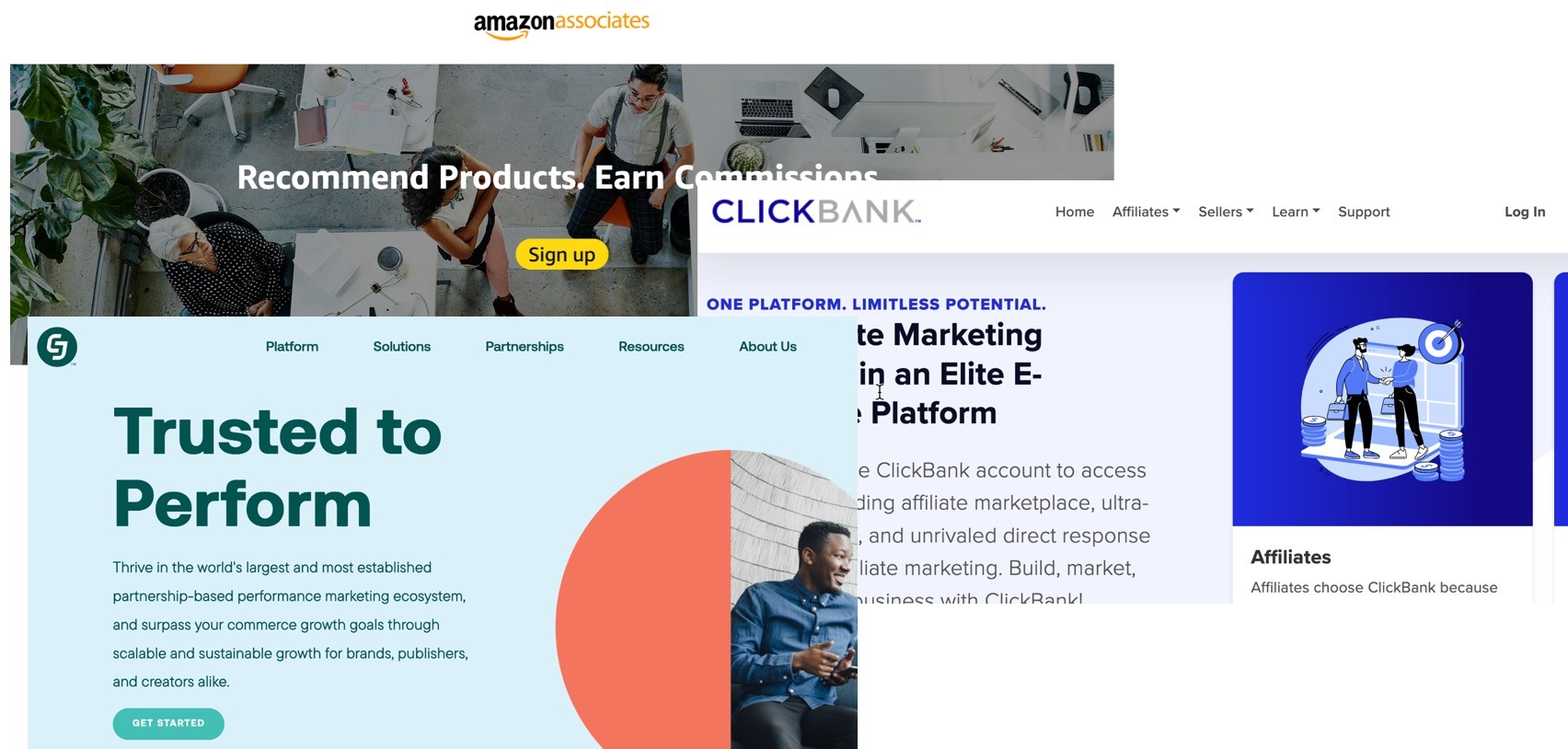Ready to dive into the world of affiliate marketing?
Using this strategy means partnering with merchants and earning commissions by promoting their products—no inventory or customer support needed!
But how do you get started?
In this guide, we'll walk you through the essentials of launching your first affiliate marketing campaign:
- Understand the basics of affiliate marketing
- Select the right programs
- Optimize your content for search engines
- Leverage social media effectively
- Create content that converts
- Track the success of your efforts
Ready to start earning through affiliate marketing?
Keep reading to discover step-by-step tips that will set you on the path to success and help you avoid common pitfalls.
Let’s get started!... 🚀
Understand Affiliate Marketing Basics
Before you jump into the world of affiliate marketing, it's crucial to grasp the foundational elements.
Here’s a breakdown to simplify these concepts:
Types of Affiliate Marketing Models
To maximize your earnings, it’s essential to understand the different types of affiliate marketing models:
- Pay-Per-Click (PPC)—you earn money based on the number of visitors you redirect from your affiliate site to the merchant’s website, regardless of whether a sale is made.
- Pay-Per-Lead (PPL)—this model pays you based on the conversion of leads. you receive compensation when visitors fill out a form, sign up for a trial, or complete some action on the merchant’s site.
- Pay-Per-Sale (PPS)—the most common model, PPS allows you to earn a percentage of the sale price when the purchase is completed.
How Commissions Are Earned
Commissions can vary dramatically, depending on the affiliate program and the product being promoted.
- You could earn anywhere from 1% to 50% per sale, typically tracked via affiliate links and cookies.
Here's a quick insight:
Always check the commission structure before joining an affiliate program.
Higher ticket items might offer lower percentage commissions but can potentially earn you more per sale.
Understanding these basics sets the stage for you to choose the right affiliate programs and start crafting content that converts.
Remember, your role as an affiliate is to bridge the gap between consumers and the products or services they're interested in. 🌉
Let’s make sure your journey in affiliate marketing is built on a solid foundation!..
Choose the Right Affiliate Programs
Selecting an affiliate program that aligns with your niche and audience preferences is crucial for your success.
Here's how to make a well-informed choice:
1. Align with Your Niche
Choose programs that match the interests of your audience and complement the content you create.
If your blog is about fitness, affiliate programs for health supplements or workout gear would be a perfect match.
2. Evaluate the Merchant’s Credibility
Partner with reputable merchants to maintain trust with your audience.
Research the merchant's track record and read reviews from other affiliates to ensure they are reliable and fair in their dealings.
3. Consider the Commission Structure
Look for affiliate programs that offer attractive commissions to maximize your earnings.
Higher commissions aren't always better if the product is harder to sell, so balance potential earnings with product appeal.
Don’t overlook programs with lower commissions if they offer high conversion rates or recurring commissions.
4. Cookie Duration
Cookie duration refers to how long the cookie will track a user’s clicks.
Longer durations (like 30 days or more) give you a better chance to earn a commission if a visitor buys later.
5. Program Support
Good affiliate programs provide excellent support with marketing materials, insights into best-selling products, and responsive contact points for queries.
Join forums or groups where other affiliates share their experiences.
This can provide valuable insights into which programs are currently performing well and any potential issues to watch out for.
Popular Affiliate Networks to Consider:
- Amazon Associates—great for beginners due to its wide range of products and trusted brand. However, note the shorter cookie length (24 hours).
- ClickBank—known for digital products with high commission rates, making it ideal for niches like e-learning and health.
- CJ Affiliate (CJ)—offers a vast array of products and services across different sectors with a mix of PPC, PPL, and PPS models.

Choosing the right affiliate programs is more than just signing up; it’s about forming partnerships that benefit you, the merchant, and your audience.
With these tips, you're well on your way to making informed decisions that lay the groundwork for a successful affiliate marketing venture. 🚀
Set Up Your Affiliate Marketing Platform
Now that you've chosen the right affiliate programs, the next step is to set up an effective platform to promote your affiliate products.
Here’s a step-by-step guide to getting started:
1. Choose the Right Platform
Your platform is where you'll attract and engage your audience.
Consider these popular options:
You can use multiple platforms to increase your reach and impact.
2. Setting Up a Website
If you choose to start a blog or website, follow these steps:
- Domain name—pick a unique and relevant domain name that reflects your niche.
- Hosting—choose a reliable hosting provider like Bluehost or SiteGround to ensure your site runs smoothly.
- Install WordPress—most hosting providers offer easy WordPress installation. Opt for a theme that is clean and mobile-friendly.
3. Creating Content
Content is king in affiliate marketing.
Focus on quality and relevance:
Always ensure your content provides real value to your audience.
This builds trust and increases the likelihood of conversions.
4. SEO Optimization
Optimize your content for search engines to increase visibility:
- Keywords—use tools like Google Keyword Planner to find relevant keywords.
- On-page SEO—ensure proper use of tags, meta descriptions, and URLs.
- Quality backlinks—link building can significantly boost your SEO efforts.
Setting up your affiliate marketing platform with a focus on quality content and SEO can dramatically increase your reach and success in affiliate marketing.
Remember, the foundation you build now will support your growth in the long run. 🚀
Create High-Quality Content
Crafting engaging and trustworthy content is at the heart of successful affiliate marketing.
Here's how you can create content that not only attracts but also converts your audience:
1. Understand Your Audience
Start by knowing who your readers are, what they need, and what problems they are trying to solve.
Tailoring your content to meet these needs increases relevance and engagement.
2. Content Types That Perform Well
3. Focus on Providing Value
Your content should educate, inform, or solve a problem.
Whether it’s a blog post, video, or social media update, ensure it offers real value.
Use bullet points, lists, and subheadings to make your information easy to digest.
4. Incorporate Visuals
People process visuals 60,000 times faster than text.
Include images, infographics, or videos to make your content more appealing and engaging.
5. Optimize for SEO
- Keywords—integrate relevant keywords naturally into your content to help boost your SEO rankings.
- Meta descriptions—write compelling meta descriptions with keywords to improve click-through rates from search engine results pages.
6. Call to Action (CTA)
End your content with a strong CTA.
Encourage readers to click on your affiliate links by suggesting they “find out more” or “buy now to enjoy this benefit”.
7. Update Regularly
Keep your content fresh and up-to-date.
Updating your posts can improve SEO and show your audience that you're committed to providing current information.
Always disclose your affiliate relationships upfront to maintain transparency with your audience.
This not only builds trust but is also a requirement in many jurisdictions.
Creating high-quality content isn’t just about filling your site with words and links.
It’s about crafting stories and information that resonate with your audience and encourage them to take action. 🌟
Optimize for SEO
Search Engine Optimization (SEO) is essential for ensuring your affiliate content reaches its target audience.
Here’s how to refine your SEO strategy to boost visibility and drive more clicks to your affiliate links:
1. Keyword Research
Incorporate primary keywords naturally in titles, headers, and throughout your content, but avoid keyword stuffing as it can negatively impact your SEO.
2. On-Page SEO Tactics
- Title tags and meta descriptions—these are critical elements that can influence click-through rates from search engine results pages. Make sure they are compelling and include main keywords.
- Header tags—organize content clearly using H1, H2, and H3 tags. This not only helps with SEO but also improves readability for your audience.
- Alt text for images—describe images using alt text to improve accessibility and SEO.
Ensure your URLs are short and include a keyword.
This can help search engines and users understand what the page is about.
3. Content Optimization
4. Building Backlinks
- Guest posting—write articles for other blogs in your niche to get quality backlinks.
- Collaborations—partner with influencers or other bloggers to create content that links back to your site.
5. Mobile Optimization
6. Use of Social Media
- Share your content—social signals may indirectly influence your SEO. Share posts across your social media platforms to drive traffic.
SEO is an ongoing process.
Use analytics to track what's working and refine your strategies accordingly.
Remember, the goal is to make it easy for search engines and users to find, understand, and trust your content. 🚀
SEO isn’t optional—opt for long‑tail keywords, clean on‑page tags, meta descriptions, backlinks, and mobile‑friendly design to boost discoverability.Click To Post OnLeverage Social Media
Social media isn't just a tool for engagement; it's a powerful platform to amplify your affiliate marketing efforts.
Here’s how to use social media effectively to boost your affiliate campaigns:
1. Choose the Right Platforms
Use social media analytics tools to understand where your engagements are highest.
2. Content Matters
- Educational posts—share tips or how-to guides related to your affiliate products.
- Product showcases—use high-quality images or videos to show the product in action.
- Live demos—engage with your audience in real-time using live features to demonstrate product use or answer questions.
Tailor your content format to suit the platform.
For example, short and catchy posts work best on X (Twitter), while longer, story-driven posts can perform well on Facebook.
3. Integrate Affiliate Links Wisely
4. Engage and Interact
- Respond to comments—show your audience that you value their input by responding to comments and messages.
- Encourage feedback—ask your followers about their experiences with the products you promote. This can provide you with valuable insights and content ideas.
5. Track Your Results
Social media can significantly enhance your affiliate marketing strategy by increasing visibility and driving traffic.
Remember, consistency is key. Regular posts and interactions can help build a loyal following who trust your recommendations. 🌟
Analyze and Improve Your Strategy
Once your affiliate marketing efforts are underway, it’s crucial to analyze the results and refine your strategies for improved performance.
Here’s how to effectively monitor and enhance your affiliate campaigns:
1. Track Your Performance
- Analytics tools—utilize tools like Google Analytics to track how your affiliate links perform. Monitor metrics such as click-through rates (CTR), conversion rates, and the average order value.
- Affiliate dashboard—most affiliate programs provide a dashboard where you can see your earnings and track which products are performing best.
Set up goals in Google Analytics to better understand how your affiliate links lead to sales.
2. Evaluate What Works
- Top-performing content—identify which pieces of content generate the most affiliate revenue. Look for patterns—what topics, styles, or formats seem to resonate most with your audience?
- Traffic sources—determine where your traffic is coming from. Are most of your visitors coming from search engines, social media, or direct links? This insight can help guide where you should focus your marketing efforts.
3. A/B Testing
- Experiment—test different elements of your affiliate content to see what improves engagement and conversions. For example, try different call-to-action (CTA) placements or phrasing.
- Tools—use platforms like Optimizely or Google Optimize for straightforward A/B testing.
4. Seek Feedback
- Surveys and Polls—occasionally, engage your audience with surveys or polls to gather feedback on your content and their purchasing decisions.
- Comments section—pay attention to comments on your posts or social media updates. They can provide valuable insights into what your audience thinks about the products or your content strategy.
5. Adjust Based on Insights
- Pivot as needed—use the data you’ve gathered to tweak your strategies. Perhaps you need to focus more on SEO, or maybe your social media engagement could use a boost.
- Content updates—regularly update your most popular posts to keep them relevant and maintain high search engine rankings.
Keep an eye on industry trends and new tools or platforms.
Staying updated can provide you with new opportunities to enhance your affiliate marketing strategy.
Regularly analyzing and refining your approach is key to staying ahead in the competitive world of affiliate marketing. By being proactive and responsive to data, you’ll continue to grow your audience and increase your earnings. 📈 🚀
Track and refine: use analytics and affiliate dashboards to monitor CTRs, conversions, top content, and traffic sources—then iterate based on insights.Click To Post OnAvoid These Common Pitfalls in Affiliate Marketing
Embarking on your affiliate marketing journey can be exciting, but it’s easy to stumble along the way.
Here are some common pitfalls you should avoid to keep your path to success clear and straightforward:
Not every product will resonate with your audience. Promote products that align with your niche and have real value for your readers.
Conduct thorough research before selecting products to ensure they have a good reputation and strong customer satisfaction.
SEO drives organic traffic to your content, which is crucial for long-term success. Neglecting SEO can severely limit your visibility and reach.
Regularly optimize your content and stay updated with the latest SEO trends and algorithms.
Too many links can overwhelm your audience and detract from the user experience. It might also trigger spam filters, reducing your site's search engine rankings.
Instead, strategically place affiliate links within high-quality content where they feel most natural.
What isn't measured can't be improved. Without tracking, you won’t know what’s working and what’s not.
Utilize analytics tools to monitor the performance of your affiliate links and adjust your strategies accordingly.
Quality trumps quantity. High-quality, valuable content fosters trust and keeps your audience coming back for more.
Regularly review your content to ensure it maintains high standards and is up-to-date.
Transparency is key in affiliate marketing. Failing to disclose affiliate relationships can lead to penalties and loss of trust.
Always clearly disclose your affiliate links. A simple disclaimer at the beginning of your content can suffice.
Regular A/B testing can significantly improve your click-through and conversion rates.
Use tools like Google Optimize for easy A/B testing of your affiliate content and strategies.
Avoiding these common pitfalls will help ensure your affiliate marketing efforts are effective and sustainable. Keep these tips in mind, and you’ll be on your way to building a profitable affiliate marketing business. 🚀
Frequently Asked Questions
What is affiliate marketing?
Affiliate marketing is a strategy where you earn commissions by promoting a merchant's products or services through various channels like blogs or social media.
How can I choose the right affiliate programs?
Select programs that align with your niche, offer competitive commissions, have a reputable merchant, and provide a reasonable cookie duration.
What are the best platforms for affiliate marketing?
Blogs, YouTube channels, and social media platforms like Instagram and Facebook are effective for affiliate marketing.
How can I optimize my content for SEO in affiliate marketing?
Use relevant keywords, ensure proper on-page SEO practices, build quality backlinks, and regularly update your content.
How do I track the success of my affiliate marketing efforts?
Use tools like Google Analytics to monitor click-through rates, conversion rates, and the performance of your affiliate links.
To Conclude
Affiliate marketing success comes from building on the right foundations:
Leveraging social media, refining SEO, and consistently analyzing performance will help you adapt quickly, focus on what works, and steadily improve ROI.
With a commitment to transparency, quality, and ongoing optimization, you can turn clicks into conversions and audience engagement into long-term revenue.
Start today, refine as you go, and watch your affiliate marketing results grow. 🚀












